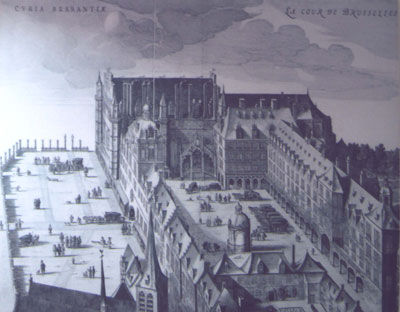Coudenberg: a palace unearthed
This item appears on page 67 of the March 2010 issue.
by Julie Skurdenis
Coudenberg was one of the most important palaces of its time, comparable to the great royal residences in other European countries. On a hill overlooking Brussels, the Dukes of Brabant built a small castle in the 11th century. By 1250 that castle had become their main ducal residence as Brussels emerged as the political center of Brabant in what is now Belgium.
As the power of the dukes grew, especially after Philip the Good inherited Burgundy, so did their castle, gradually becoming transformed from a fortified residence into a palatial one. Philip the Good built a Great Hall in the mid-15th century. Emperor Charles V added a magnificent chapel in the following century. There were extensive gardens surrounding the palace and valuable artworks decorating its rooms.
But in 1731 a huge fire ravaged the palace, leaving little intact. Four decades later, what was left was razed and a new palace rose over the old.
Excavations to recover the ancient palace that existed for almost 700 years began only toward the end of the last century. In March 2009 the archaeological site of Coudenberg Palace was finally opened to the public. Visitors now can walk along medieval streets and into two Gothic buildings dating from the time of Charles V and his immediate predecessors.
Beneath Place Royale
Entry to the archaeological site beneath the Place Royale is through a building to the right of today’s Royal Palace. Descending underground, visitors guide themselves through cellars and vaults that span 400 years, from the 12th to the 15th centuries, until they step into the stone underpinnings of the late-Gothic chapel built by Charles V between 1522 and 1553.
Octagonal columns once supported the pillars in the chapel above. The stonework here is intricate, giving an idea of what once must have existed in the chapel itself.
Emerging from the chapel, visitors walk along cobblestoned rue Isabelle, a slightly uphill stretch of street that linked the chapel to the adjacent Great Hall. I always enjoy walking along streets once trod hundreds of years ago, whether it be in Pompeii, Cuzco or Jerusalem. Rue Isabelle was no exception as I imagined strolling from a service in the chapel to a banquet in the Great Hall.
The Great Hall, called the Aula Magna, was the palace’s banqueting hall. Visitors walk on the foundations of the hall that once stood above, although you still can see part of the floor of the actual banqueting hall that collapsed into these foundations. Next to this floor is a staircase that once led to one of the towers.
Nearby is a keystone decorated with the emblems of Philip the Good, the duke who built this huge hall, 132 feet by 53 feet, between 1452 and 1460. It was in this hall that Charles V abdicated in 1555, turning over the Netherlands that, then, included present-day Belgium to his son Philip II.
Nobles and court advisors lived close to Coudenberg Palace in sumptuous mansions. On rue Isabelle and just across from the chapel was the home of the Counts of Hoogstraeten, one of whom, Antoine de Lalaing, served as chief advisor to Charles V. This mansion now houses some of the many items of everyday life found during the excavation, including ceramics, glass objects and clay pipes.
Contact Coudenberg Palace (Place des Palais, 7, 1000 Bruxelles, Belgium; phone +32 [0] 70 22 04 92). (Note: the Coudenberg ruins are underground and visitors must enter via another museum, the BELvue.) Open year-round, Tuesday to Friday 10 to 5 and Saturday and Sunday 10-6.
Day excursions
If time permits, no visitor to Belgium should miss day excursions or overnights to Bruges, Antwerp and Ghent, each within an hour or two of Brussels using the frequent train service. If you can choose only one, make it Bruges (or Brugge, as it’s called in Dutch).
One of the many highlights in Bruges is the Onze-Lieve-Vrouwekerk (Church of Our Lady). It fits in nicely with a visit to Coudenberg Palace because it is here that one of the greatest Burgundian dukes, Charles the Bold, lies in a magnificent tomb. He died in battle and now rests beside his daughter, Mary of Burgundy, who succeeded him. This daughter married the Holy Roman Emperor Maximilian I of Austria.
Charles the Bold was the son of Philip the Good and the great grandfather of Charles V. All three had strong ties with Coudenberg Palace.
Brussels Card
An excellent value for those interested in museums and in using public transportation is the Brussels Card, which can be purchased online or in Brussels at the Grand’Place Tourist Office, some museums and some metro stations; check online for the complete list.
Cards cost €19 ($29) for 24 hours, €27 for 48 hours and €32 ($48) for 72 hours. The card comes with a booklet listing shops, restaurants, bars and tours offering discounts to cardholders.
If you go…
For our 16 days in Brussels in April ’09, my husband, Paul, and I enjoyed the perfect location, an apartment about a five-minute walk from the Grand’Place, one of the most beautiful squares in Europe. Our one-bedroom apartment was sleek and modern and came with a large terrace with a view of the Hôtel de Ville (City Hall), magnificently lit at night.
We rented through B-Aparthotels (Square Ambiorix 28, 1000 Brussels, Belgium; phone 32 [0] 2 743 5111), which has four apartment complexes in Brussels. Rates begin at €78 per night (near $117). We paid €99 per night.

